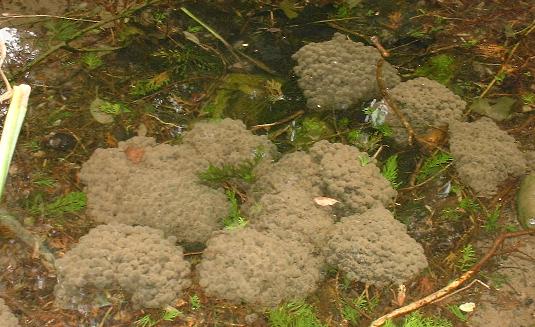A mature frog, uncovered in long grass as it hibernated. The colours on its back make
it difficult distinguish from its surroundings.
The Common Frog is the most widespread species in Europe.
Their relatively smooth skin varies in colour from olive green and yellow, to dark brown, speckled with black, brown or red and can lighten or darken to blend in with the surroundings. There are dark cross bars on the limbs and a dark patch behind the eyes. The under side of the body is off-white or yellow with some speckles. The skin can also be used to 'breathe' when oxygen demand is low such as when hibernating through the winter in the debris at the bottom of a pond - they will also hibernate in cool moist conditions under logs or other plant debris where it is unlikely to freeze.
Males are slightly smaller than the females - an average size for an adult is 7.5 to 8 cm and 23g in weight. The males also have dark pads or swellings on the first digits of the fore legs which are used during mating to grip the female; they become more pronounced during the mating season. The long muscular hind limbs enable them to leap about 50cm.
They prefer to be in cool, moist conditions under dense herbaceous foliage where they prey on invertebrates like slugs, snails, worms and insects, trapping them with their long, sticky tongues. This makes them a garden friend as anything which reduces the slug and snail population is most welcome. Apart from during the breeding season they are found in gardens, open fields and in woods, coming to bodies of shallow water in the spring to find a mate. They do not search for food in water, and do not feed during the mating period. In the food chain, frogs form part of the diet of birds such as herons, foxes and other hunting mammals - domestic cats can be a problem.
In their third year frogs become sexually mature and in early spring they go to a suitable pond or stream, which is usually where they were bred. The males arrive first and attract the females by emitting a low croaking sound. Taking to the water the courtship is short as the male swiftly grips onto the female and she begins to release up to 2000 black spherical eggs about 2-3mm in diameter. The male simultaneously releases his sperm over the eggs which must fertilize them before the gelatinous coating swells to form a protective raft.

Some frog spawn, the 'muddy' look caused by storm water which coated it with silt.
After 10 to 20 days, depending on the temperature, the black central egg develops into a tadpole with a yolk-sack which it digests for its initial nourishment. A few days later the mouth, external gills and eyes have formed, the tadpole leaves the protection of the egg-raft and more normal feeding can begin on algae in the water or growing on plants. At about five weeks old the hind legs start to grow as do the lungs, and the tadpole begins to swim to the surface of the water for air. Up until this point it has been living on plant material, but rasping teeth have formed and it adds to its diet with insects and other tadpoles.
These tadpoles share the pond with Water Slaters (Asellus aquaticus)on the right and
a red Midge larva protrudes from the silt, bottom left of centre.
The numbers begin to decrease due to this canabalism and predation from birds or fish (if they are present).
At around ten weeks the tail starts to be reduced and the fore legs start developing. Four weeks later the metamorphosis is almost complete and the froglet begins to spend time out of the water on rocks and plants. This time scale may be longer in cooler regions or if food is scarce. Of the large quantity of eggs produced, only about 1 to 2 percent make it through to adulthood. The total life span of a frog can be about seven to eight years.
A young frog in its 2nd year, about 3cm long
The number of frogs has been declining in recent years, but the reason is not known for definite. One cause is a bacterial disease known as Red Leg. The name comes from the red lesions it causes on the hind legs and underbelly of the frog. It may have been introduced to the British Isles with imported fish or other material brought in for ornamental ponds. It is highly contagious and will kill all the frogs in an area. Prevention is the only answer, so spawn should never be transferred from a pond and material or fish from garden ponds should never be disposed of in the wild.
Other things blamed for the reduction in frog numbers are shrinking habitat due to drainage schemes and industrial farming methods, increases in UV light intensity, heavy metal and chemical pollution, and acid rain. As with most wildlife, they are protected by the Wildlife and Countryside Act 1981 against exploitation for sale.
To attract frogs to your garden, provide plenty of cover for them so don't be too tidy, leaving a few piles of leaves and dark, damp corners for them to shelter in. The additon of some kind of pond with shallow edges will probably mean they will start to breed there as well.
Back to GARDEN CREATURES, or use the drop-down menus at the top of the page to find other garden-related articles.